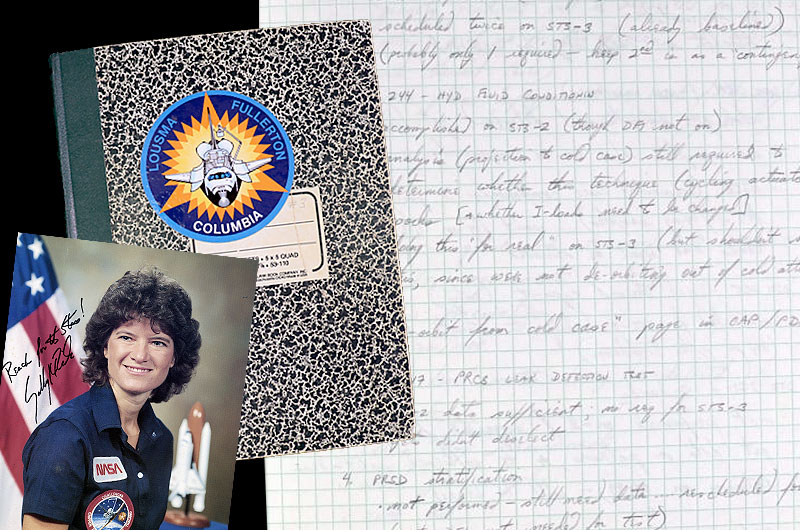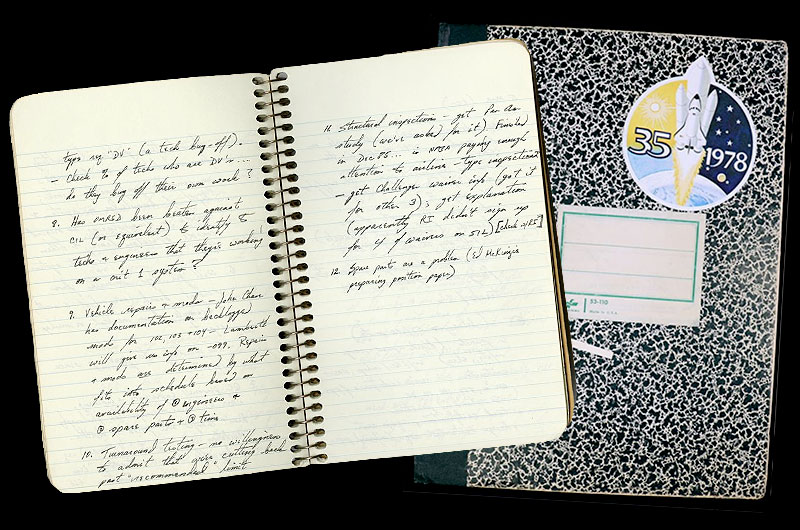Smithsonian seeks public's help with Sally Ride's astronaut training notes

Before she became the first American woman to fly into space, Sally Ride needed to learn how to be an astronaut. Now, 30 years later, the public can help expand access to Ride's training experience by volunteering to transcribe her extensive handwritten notes.
The National Air and Space Museum has begun the process of converting the 23 cubic feet of material it obtained from Ride's estate in 2015 to be available for research and study. Archivists have scanned and indexed the entire collection, but more can be done to make the papers fully searchable.
The museum has now added to the Smithsonian Transcription Center's website Ride's 1979 and 1980 NASA notebooks, as well as some of her flying instructions and training schedules. The public can sign up to help transcribe the papers, as well as review the work of other volunteers (or "volunpeers" as the museum's staff calls them).
In Photos: Sally Ride, the 1st American woman in space
"These new digital assets [will] allow for a much larger audience to view and engage with the entire collection," archivist Patti Williams wrote on Monday (March 23), announcing the project. "Without ever visiting the National Air and Space Museum Archives, researchers and students can gain insight into Ride's lifetime of professional achievements, as an astronaut, physicist, and educator."
Among the first people to lend time to the transcription project have been Ellen Stofan, the director of the National Air and Space Museum, and the Secretary of the Smithsonian, Lonnie Bunch.
"When my friend and colleague Ellen Stofan mentioned she's spending some of Women's History Month transcribing astronaut Sally Ride's materials, I was eager to dig in," Bunch wrote on Twitter. "This was before Ellen told me there are 38,640 pages!"
Breaking space news, the latest updates on rocket launches, skywatching events and more!
"Ride kept a trove of documents that can deepen our understanding of her journey to space and her achievements on Earth. If you, too, want to reconnect with history or marvel at the wonders of space exploration, join Ellen, the Smithsonian Transcription Center and me to transcribe," he wrote.
Ride, who died in 2012, was selected to become an astronaut in 1978. As a mission specialist on space shuttle Challenger's STS-7 crew, she became the first U.S. woman in space.
Related: Women in Space: A gallery of firsts
Ride launched again into space in 1984 before retiring from NASA three years later. She went on to become a professor of physics at the University of California, San Diego, and an advocate for science education.
In addition to Ride's astronaut training notebooks, which in part detail her work with the space shuttle's remote manipulator system, or Canadarm robotic arm, the Smithsonian is also looking to the public for help transcribing Ride's notes from the NASA commissions on which she served, including the investigations into the space shuttle Challenger and Columbia tragedies in 1986 and 2003, respectively.
"You may know of Ride as the first American woman in space, a leader of integrity who served on committees investigating NASA accidents, an educator, an inspiration," wrote Bunch. "But beyond the icon status — postage stamp, name drop in [Billy Joel's] 'We Didn't Start the Fire' — she was a real, nuanced person."
"You may discover a new story while you make Ride's work more accessible to researchers and the next generation of space explorers," he wrote.
- Sally Ride's Legacy: Encouraging Young Women to Embrace Science and Engineering
- Barbie Hails Astronaut Sally Ride With New 'Inspiring Women' Doll
- Sally Ride's life partner weighs in on the future of LGBTQ+ astronauts
Follow collectSPACE.com on Facebook and on Twitter at @collectSPACE. Copyright 2017 collectSPACE.com. All rights reserved.
OFFER: Save at least 56% with our latest magazine deal!
All About Space magazine takes you on an awe-inspiring journey through our solar system and beyond, from the amazing technology and spacecraft that enables humanity to venture into orbit, to the complexities of space science.

Robert Pearlman is a space historian, journalist and the founder and editor of collectSPACE.com, a daily news publication and community devoted to space history with a particular focus on how and where space exploration intersects with pop culture. Pearlman is also a contributing writer for Space.com and co-author of "Space Stations: The Art, Science, and Reality of Working in Space” published by Smithsonian Books in 2018.
In 2009, he was inducted into the U.S. Space Camp Hall of Fame in Huntsville, Alabama. In 2021, he was honored by the American Astronautical Society with the Ordway Award for Sustained Excellence in Spaceflight History. In 2023, the National Space Club Florida Committee recognized Pearlman with the Kolcum News and Communications Award for excellence in telling the space story along the Space Coast and throughout the world.



